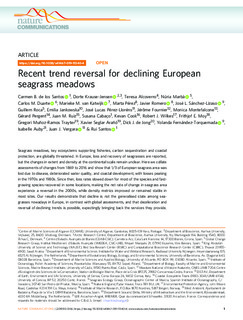| dc.contributor.author | de los Santos, Carmen B | |
| dc.contributor.author | Krause-Jensen, Dorte | |
| dc.contributor.author | Alcoverro, Teresa | |
| dc.contributor.author | Marba, Núria | |
| dc.contributor.author | Duarte, Carlos M. | |
| dc.contributor.author | van Katwijk, Marieke M | |
| dc.contributor.author | Perez, Marta | |
| dc.contributor.author | Romero, Javier | |
| dc.contributor.author | Sanchez-Lizaso, Jose L | |
| dc.contributor.author | Roca, Guillem | |
| dc.contributor.author | Jankowska, Emilia | |
| dc.contributor.author | Perez-Llorens, Jose Lucas | |
| dc.contributor.author | Fournier, Jérôme | |
| dc.contributor.author | Montefalcone, Monica | |
| dc.contributor.author | Pergent, Gerard | |
| dc.contributor.author | Ruiz, Juan M | |
| dc.contributor.author | Cabaco, Susana | |
| dc.contributor.author | Cook, Kevan | |
| dc.contributor.author | Wilkes, Robert J | |
| dc.contributor.author | Moy, Frithjof Emil | |
| dc.contributor.author | Trayter, Gregori Munoz-Ramos | |
| dc.contributor.author | Arano, Xavier Seglar | |
| dc.contributor.author | de Jong, Dick J | |
| dc.contributor.author | Fernandez-Torquemada, Yolanda | |
| dc.contributor.author | Auby, Isabelle | |
| dc.contributor.author | Vergara, Juan J | |
| dc.contributor.author | Santos, Rui | |
| dc.date.accessioned | 2020-02-07T08:07:05Z | |
| dc.date.available | 2020-02-07T08:07:05Z | |
| dc.date.created | 2020-01-27T19:44:40Z | |
| dc.date.issued | 2019 | |
| dc.identifier.citation | Nature Communications. 2019, 10 (1), 1-8. | nb_NO |
| dc.identifier.issn | 2041-1723 | |
| dc.identifier.uri | http://hdl.handle.net/11250/2640144 | |
| dc.description.abstract | Seagrass meadows, key ecosystems supporting fisheries, carbon sequestration and coastal protection, are globally threatened. In Europe, loss and recovery of seagrasses are reported, but the changes in extent and density at the continental scale remain unclear. Here we collate assessments of changes from 1869 to 2016 and show that 1/3 of European seagrass area was lost due to disease, deteriorated water quality, and coastal development, with losses peaking in the 1970s and 1980s. Since then, loss rates slowed down for most of the species and fast-growing species recovered in some locations, making the net rate of change in seagrass area experience a reversal in the 2000s, while density metrics improved or remained stable in most sites. Our results demonstrate that decline is not the generalised state among seagrasses nowadays in Europe, in contrast with global assessments, and that deceleration and reversal of declining trends is possible, expectingly bringing back the services they provide. | nb_NO |
| dc.language.iso | eng | nb_NO |
| dc.title | Recent trend reversal for declining European seagrass meadows | nb_NO |
| dc.type | Journal article | nb_NO |
| dc.type | Peer reviewed | nb_NO |
| dc.description.version | publishedVersion | nb_NO |
| dc.source.pagenumber | 1-8 | nb_NO |
| dc.source.volume | 10 | nb_NO |
| dc.source.journal | Nature Communications | nb_NO |
| dc.source.issue | 1 | nb_NO |
| dc.identifier.doi | 10.1038/s41467-019-11340-4 | |
| dc.identifier.cristin | 1783583 | |
| cristin.unitcode | 7431,28,0,0 | |
| cristin.unitname | Bunnsamfunn og kystinteraksjon | |
| cristin.ispublished | true | |
| cristin.fulltext | original | |
| cristin.qualitycode | 2 | |
